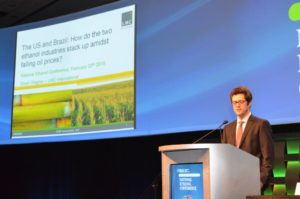 Renewable Fuels Association President, Bob Dinneen introduces NEC scholarship winner, Lais Thomaz at the National Ethanol Conference.
Renewable Fuels Association President, Bob Dinneen introduces NEC scholarship winner, Lais Thomaz at the National Ethanol Conference.
by Lais F. Thomaz* (Advanced Biofuels USA) Last week, from February 17 to 21, the 20th National Ethanol Conference "Going Global" was held in Grapevine, Texas, with the participation of several representatives of the ethanol production chain in the States and other countries such as Brazil, Germany, Canada, Italy, Peru, Ireland, Mexico, England, India and Ghana.
One issue was clear: the delayed disclosure of the renewable fuels volume obligation (RVO) of the Renewable Fuel Standard (RFS) has the sector concerned about the US market, which further boosts initiatives to explore the international market.
Bob Dinneen, President of the Renewable Fuels Association (RFA), said in his opening speech that included the 10 points of ethanol agenda, the fact that the association works together with the US Grains Council and Growth Energy in an Ethanol Exports Program.
The goal is to maintain the level of exports which reached a record 1.2 billion gallons of ethanol in 2011. Sixtyone countries have been mapped that possess ethanol mandates and can be exploited, and the organizations have trade missions planned for Brazil, Peru, Panama, the Philippines, Japan, South Korea and China.
This proposal is reinforced by the former US Trade representative Ron Kirk's speech in the conference too. Kirk emphasized the importance of the ethanol industry supporting the approval of the Trade Promotion Authority (TPA) which will facilitate the conclusion of agreements such as the Transpacific Partnership (TPP) and the Transatlantic Trade and Investment Partnership (TTIP). Jim Galvin, President of Lakeview Energy, also pointed out that among the sector's challenges is to not be left out of such agreements.
RFS "Back on Track"?
 RFA's Bob Dinneen listens as US Environmental Protection Agency's Christopher Grundler repeats EPA's promise that the RVO numbers for 2014 will be announced in the Spring.
RFA's Bob Dinneen listens as US Environmental Protection Agency's Christopher Grundler repeats EPA's promise that the RVO numbers for 2014 will be announced in the Spring.
Christopher Grundler, Director in the Office of Air Quality and Transportation at the US Environmental Protection Agency (EPA), said that the RVO numbers for 2014, 2015 and 2016 are not yet finalized. The commitment is that by the end of June this year the EPA should disclose them. His justification for the delay highlights the analysis of the various comments received and orders linked to new ideas and new types of raw materials for renewable fuels.
Nevertheless, the RFA intends to work for a growth trajectory overcoming the restrictions of the percentage of ethanol in gasoline (blend wall) and encouraging the market for renewable identification numbers (RINs), which are used to track the renewable fuels used for transport.
No matter what happens with the RFS, the sector aims to increase market opportunities for mixtures of top-level ethanol, including E15 and E85.
Cellulosic Ethanol Technology
 Representatives of trade organizations: National Corn Growers Association, API, AAM, Fuels Institute, and the Advanced Ethanol Council
Representatives of trade organizations: National Corn Growers Association, API, AAM, Fuels Institute, and the Advanced Ethanol Council
Representatives of cellulosic ethanol plants that are now operating in the US presented their initial results and future prospects.
Abengoa began operations at its Hugoton Plant in Kansas in October 2014. This plant is expected to produce 25 million gallons per year from corn stover and other cellulosic feedstock using enzymatic hydrolysis.
Dupont's cellulosic ethanol project, located in Nevada, Iowa—with capacity of 30 million gallons per year—has a partnership with USDA Natural Resources Conservation Service and Iowa State University. Dupont and Procter & Gamble recently announced a partnership to produce liquid soap "Tide" from cellulosic ethanol. Dupont is also working to produce cellulosic ethanol in Macedonia.
 Beta Renewables, represented by Paollo Carollo, partners with GranBio in a Bioflex facility which was inaugurated in October 2014 in Alagoas, Brazil. It is expected to produce 21 million gallons per year.
Beta Renewables, represented by Paollo Carollo, partners with GranBio in a Bioflex facility which was inaugurated in October 2014 in Alagoas, Brazil. It is expected to produce 21 million gallons per year.
The RFS encourages investment in new technologies using cellulose, however, in the industry's view it is also necessary to create a level playing field for cellulosic biofuels, which implies long-term tax incentives. Therefore, the RFA should work together with the Advanced Ethanol Council. Their strategy includes reaching members of Congress to ask for the end of oil industry incentives and to renew incentives for cellulosic ethanol, which, up to now, have only been used last year.
For the US, the development of cellulosic ethanol can be a huge political gain since future installations can be found in states that are not located in the Corn Belt. This makes the regional issue become national, gaining more weight in Congress.
Challenges for Brazilian Ethanol
The presentations highlighting Brazil were those by Pedro Paranhos, Vice President of Eco-energy and Owen Wagner of LMC International. Wagner pointed out that although Brazilian ethanol processing costs are lower than in the US, total production costs (including costs of raw material) in the US were lower than in Brazil over the past years. This is one reason why the Brazilian ethanol industry has been less profitable in the US since 2011.
This contributes to the fact that Brazil and the United States have shifted position in the international market. Paranhos pointed out that in 2014, US exports accounted for 70% of the ethanol exports market and Brazil had only 30%. In 2004, the US accounted for 10% and Brazil had 90%.
On the other hand, Wagner emphasized that there can be improvements in production efficiency. On the demand side, the adoption of 27% ethanol in gasoline in Brazil should also contribute to more incentives in the industry. Another highlight is the fact that the government of Minas Gerais has reduced the value-added tax on sales and services (ICMS) for ethanol to 14%, which decreases ethanol prices in that state. In any case, Wagner argues that this opened a window of opportunity for the US to increase ethanol exports to the Brazilian market.
Paranhos stressed that the Japanese and South Korean markets still favor Brazilian ethanol due to regulations that restrict the market to cane ethanol. It is noteworthy that Brazilian industry representatives have been successful in the defense of Brazilian ethanol in the state politics of California (Low Carbon Fuel Standard - LCFS). In this sense, more than a hundred Brazilian mills are registered with the California Air Resources Board (CARB), and during the harvest of 2013/14 a quarter of Brazilian ethanol exports went to the California market. Thus, California reinforces itself as an option for Brazilian exports.
* Contributing author, Laís Thomaz, is a Visiting Researcher at Georgetown University, Department of Government and Ph.D. candidate at San Tiago Dantas Graduate Program in International Relations, Unesp/Unicamp/PUC-SP, São Paulo, Brazil. She was the winner of the scholarship to attend NEC 2015 promoted by RFA and the Renewable Fuels Foundation (RFF).
Photos courtesy of Lais Thomaz
READ MORE (Platts)
Nearly 55,000 articles in our online library!
Use the categories and tags listed below to access the nearly 50,000 articles indexed on this website.
Advanced Biofuels USA Policy Statements and Handouts!
- For Kids: Carbon Cycle Puzzle Page
- Why Ethanol? Why E85?
- Just A Minute 3-5 Minute Educational Videos
- 30/30 Online Presentations
- “Disappearing” Carbon Tax for Non-Renewable Fuels
- What’s the Difference between Biodiesel and Renewable (Green) Diesel? 2020 revision
- How to De-Fossilize Your Fleet: Suggestions for Fleet Managers Working on Sustainability Programs
- New Engine Technologies Could Produce Similar Mileage for All Ethanol Fuel Mixtures
- Action Plan for a Sustainable Advanced Biofuel Economy
- The Interaction of the Clean Air Act, California’s CAA Waiver, Corporate Average Fuel Economy Standards, Renewable Fuel Standards and California’s Low Carbon Fuel Standard
- Latest Data on Fuel Mileage and GHG Benefits of E30
- What Can I Do?
Donate
DonateARCHIVES
- July 2025
- June 2025
- May 2025
- April 2025
- March 2025
- February 2025
- January 2025
- December 2024
- November 2024
- October 2024
- September 2024
- August 2024
- July 2024
- June 2024
- May 2024
- April 2024
- March 2024
- February 2024
- January 2024
- December 2023
- November 2023
- October 2023
- September 2023
- August 2023
- July 2023
- June 2023
- May 2023
- April 2023
- March 2023
- February 2023
- January 2023
- December 2022
- November 2022
- October 2022
- September 2022
- August 2022
- July 2022
- June 2022
- May 2022
- April 2022
- March 2022
- February 2022
- January 2022
- December 2021
- November 2021
- October 2021
- September 2021
- August 2021
- July 2021
- June 2021
- May 2021
- April 2021
- March 2021
- February 2021
- January 2021
- December 2020
- November 2020
- October 2020
- September 2020
- August 2020
- July 2020
- June 2020
- May 2020
- April 2020
- March 2020
- February 2020
- January 2020
- December 2019
- November 2019
- October 2019
- September 2019
- August 2019
- July 2019
- June 2019
- May 2019
- April 2019
- March 2019
- February 2019
- January 2019
- December 2018
- November 2018
- October 2018
- September 2018
- August 2018
- July 2018
- June 2018
- May 2018
- April 2018
- March 2018
- February 2018
- January 2018
- December 2017
- November 2017
- October 2017
- September 2017
- August 2017
- July 2017
- June 2017
- May 2017
- April 2017
- March 2017
- February 2017
- January 2017
- December 2016
- November 2016
- October 2016
- September 2016
- August 2016
- July 2016
- June 2016
- May 2016
- April 2016
- March 2016
- February 2016
- January 2016
- December 2015
- November 2015
- October 2015
- September 2015
- August 2015
- July 2015
- June 2015
- May 2015
- April 2015
- March 2015
- February 2015
- January 2015
- December 2014
- November 2014
- October 2014
- September 2014
- August 2014
- July 2014
- June 2014
- May 2014
- April 2014
- March 2014
- February 2014
- January 2014
- December 2013
- November 2013
- October 2013
- September 2013
- August 2013
- July 2013
- June 2013
- May 2013
- April 2013
- March 2013
- February 2013
- January 2013
- December 2012
- November 2012
- October 2012
- September 2012
- August 2012
- July 2012
- June 2012
- May 2012
- April 2012
- March 2012
- February 2012
- January 2012
- December 2011
- November 2011
- October 2011
- September 2011
- August 2011
- July 2011
- June 2011
- May 2011
- April 2011
- March 2011
- February 2011
- January 2011
- December 2010
- November 2010
- October 2010
- September 2010
- August 2010
- July 2010
- June 2010
- May 2010
- April 2010
- March 2010
- February 2010
- January 2010
- December 2009
- November 2009
- October 2009
- September 2009
- August 2009
- July 2009
- June 2009
- May 2009
- April 2009
- March 2009
- February 2009
- January 2009
- December 2008
- November 2008
- October 2008
- September 2008
- August 2008
- July 2008
- June 2008
- May 2008
- April 2008
- March 2008
- February 2008
- January 2008
- December 2007
- November 2007
- October 2007
- September 2007
- August 2007
- June 2007
- February 2007
- January 2007
- October 2006
- April 2006
- January 2006
- April 2005
- December 2004
- November 2004
- December 1987
CATEGORIES
- About Us
- Advanced Biofuels Call to Action
- Aviation Fuel/Sustainable Aviation Fuel (SAF)
- BioChemicals/Renewable Chemicals
- BioRefineries/Renewable Fuel Production
- Business News/Analysis
- Cooking Fuel
- Education
- 30/30 Online Presentations
- Competitions, Contests
- Earth Day 2021
- Earth Day 2022
- Earth Day 2023
- Earth Day 2024
- Earth Day 2025
- Executive Training
- Featured Study Programs
- Instagram TikTok Short Videos
- Internships
- Just a Minute
- K-12 Activities
- Mechanics training
- Online Courses
- Podcasts
- Scholarships/Fellowships
- Teacher Resources
- Technical Training
- Technician Training
- University/College Programs
- Events
- Coming Events
- Completed Events
- More Coming Events
- Requests for Speakers, Presentations, Posters
- Requests for Speakers, Presentations, Posters Completed
- Webinars/Online
- Webinars/Online Completed; often available on-demand
- Federal Agency/Executive Branch
- Agency for International Development (USAID)
- Agriculture (USDA)
- Commerce Department
- Commodity Futures Trading Commission
- Congressional Budget Office
- Defense (DOD)
- Air Force
- Army
- DARPA (Defense Advance Research Projects Agency)
- Defense Logistics Agency
- Marines
- Navy
- Education Department
- Energy (DOE)
- Environmental Protection Agency
- Federal Energy Regulatory Commission (FERC)
- Federal Reserve System
- Federal Trade Commission
- Food and Drug Administration
- General Services Administration
- Government Accountability Office (GAO)
- Health and Human Services (HHS)
- Homeland Security
- Housing and Urban Development (HUD)
- Interior Department
- International Trade Commission
- Joint Office of Energy and Transportation
- Justice (DOJ)
- Labor Department
- National Academies of Sciences Engineering Medicine
- National Aeronautics and Space Administration
- National Oceanic and Atmospheric Administration
- National Research Council
- National Science Foundation
- National Transportation Safety Board (NTSB)
- Occupational Safety and Health Administration
- Overseas Private Investment Corporation
- Patent and Trademark Office
- Securities and Exchange Commission
- State Department
- Surface Transportation Board
- Transportation (DOT)
- Federal Aviation Administration
- National Highway Traffic Safety Administration (NHTSA)
- Pipeline and Hazardous Materials Safety Admin (PHMSA)
- Treasury Department
- U.S. Trade Representative (USTR)
- White House
- Federal Legislation
- Federal Litigation
- Federal Regulation
- Feedstocks
- Agriculture/Food Processing Residues nonfield crop
- Alcohol/Ethanol/Isobutanol
- Algae/Other Aquatic Organisms/Seaweed
- Atmosphere
- Carbon Dioxide (CO2)
- Field/Orchard/Plantation Crops/Residues
- Forestry/Wood/Residues/Waste
- hydrogen
- Manure
- Methane/Biogas
- methanol/bio-/renewable methanol
- Not Agriculture
- RFNBO (Renewable Fuels of Non-Biological Origin)
- Seawater
- Sugars
- water
- Funding/Financing/Investing
- grants
- Green Jobs
- Green Racing
- Health Concerns/Benefits
- Heating Oil/Fuel
- History of Advanced Biofuels
- Infrastructure
- Aggregation
- Biofuels Engine Design
- Biorefinery/Fuel Production Infrastructure
- Carbon Capture/Storage/Use
- certification
- Deliver Dispense
- Farming/Growing
- Precursors/Biointermediates
- Preprocessing
- Pretreatment
- Terminals Transport Pipelines
- International
- Abu Dhabi
- Afghanistan
- Africa
- Albania
- Algeria
- Angola
- Antarctica
- Arctic
- Argentina
- Armenia
- Aruba
- Asia
- Asia Pacific
- Australia
- Austria
- Azerbaijan
- Bahamas
- Bahrain
- Bangladesh
- Barbados
- Belarus
- Belgium
- Belize
- Benin
- Bermuda
- Bhutan
- Bolivia
- Bosnia and Herzegovina
- Botswana
- Brazil
- Brunei
- Bulgaria
- Burkina Faso
- Burundi
- Cambodia
- Cameroon
- Canada
- Caribbean
- Central African Republic
- Central America
- Chad
- Chile
- China
- Colombia
- Congo
- Congo, Democratic Republic of
- Costa Rica
- Croatia
- Cuba
- Cyprus
- Czech Republic
- Denmark
- Dominican Republic
- Dubai
- Ecuador
- El Salvador
- Equatorial Guinea
- Eqypt
- Estonia
- Eswatini/Swaziland
- Ethiopia
- European Union (EU)
- Fiji
- Finland
- France
- French Guiana
- Gabon
- Georgia
- Germany
- Ghana
- Global South
- Greece
- Greenland
- Grenada
- Guatemala
- Guinea
- Guyana
- Haiti
- Honduras
- Hong Kong
- Hungary
- Iceland
- India
- Indonesia
- Iran
- Iraq
- Ireland
- Israel
- Italy
- Ivory Coast
- Jamaica
- Japan
- Jersey
- Jordan
- Kazakhstan
- Kenya
- Korea
- Kosovo
- Kuwait
- Laos
- Latin America
- Latvia
- Lebanon
- Liberia
- Lithuania
- Luxembourg
- Macedonia
- Madagascar
- Malawi
- Malaysia
- Maldives
- Mali
- Malta
- Marshall Islands
- Mauritania
- Mauritius
- Mexico
- Middle East
- Moldova
- Monaco
- Mongolia
- Morocco
- Mozambique
- Myanmar/Burma
- Namibia
- Nepal
- Netherlands
- New Guinea
- New Zealand
- Nicaragua
- Niger
- Nigeria
- North Africa
- North America
- North Korea
- Northern Ireland
- Norway
- Oman
- Pakistan
- Panama
- Papua New Guinea
- Paraguay
- Peru
- Philippines
- Poland
- Portugal
- Qatar
- Republic of
- Romania
- Russia
- Rwanda
- Saudi Arabia
- Scotland
- Senegal
- Serbia
- Sierra Leone
- Singapore
- Slovakia
- Slovenia
- Solomon Islands
- South Africa
- South America
- South Korea
- South Sudan
- Southeast Asia
- Spain
- Sri Lanka
- Sudan
- Suriname
- Sweden
- Switzerland
- Taiwan
- Tanzania
- Thailand
- Timor-Leste
- Togo
- Trinidad and Tobago
- Tunisia
- Turkey
- Uganda
- UK (United Kingdom)
- Ukraine
- United Arab Emirates UAE
- Uruguay
- Uzbekistan
- Vatican
- Venezuela
- Vietnam
- Wales
- Zambia
- Zanzibar
- Zimbabwe
- Marine/Boat Bio and Renewable Fuel/MGO/MDO/SMF
- Marketing/Market Forces and Sales
- Opinions
- Organizations
- Original Writing, Opinions Advanced Biofuels USA
- Policy
- Presentations
- Biofuels Digest Conferences
- DOE Conferences
- Bioeconomy 2017
- Bioenergy2015
- Biomass2008
- Biomass2009
- Biomass2010
- Biomass2011
- Biomass2012
- Biomass2013
- Biomass2014
- DOE Project Peer Review
- Other Conferences/Events
- R & D Focus
- Carbon Capture/Storage/Use
- Co-Products
- Feedstock
- Logistics
- Performance
- Process
- Vehicle/Engine/Motor/Aircraft/Boiler
- Yeast
- Railroad/Train/Locomotive Fuel
- Resources
- Books Web Sites etc
- Business
- Definition of Advanced Biofuels
- Find Stuff
- Government Resources
- Scientific Resources
- Technical Resources
- Tools/Decision-Making
- Rocket/Missile Fuel
- Sponsors
- States
- Alabama
- Alaska
- Arizona
- Arkansas
- California
- Colorado
- Connecticut
- Delaware
- Florida
- Georgia
- Hawai'i
- Idaho
- Illinois
- Indiana
- Iowa
- Kansas
- Kentucky
- Louisiana
- Maine
- Maryland
- Massachusetts
- Michigan
- Midwest
- Minnesota
- Mississippi
- Missouri
- Montana
- Native American tribal nation lands
- Nebraska
- Nevada
- New Hampshire
- New Jersey
- New Mexico
- New York
- North Carolina
- North Dakota
- Ohio
- Oklahoma
- Oregon
- Pennsylvania
- Puerto Rico
- Rhode Island
- South Carolina
- South Dakota
- Tennessee
- Texas
- Utah
- Vermont
- Virginia
- Washington
- Washington DC
- West Coast
- West Virginia
- Wisconsin
- Wyoming
- Sustainability
- Uncategorized
- What You Can Do
tags
© 2008-2023 Copyright Advanced BioFuels USA. All Rights reserved.



.jpg)





0 COMMENTS
Leave A Comment
Your Email Address wiil not be Published. Required Field Are marked*